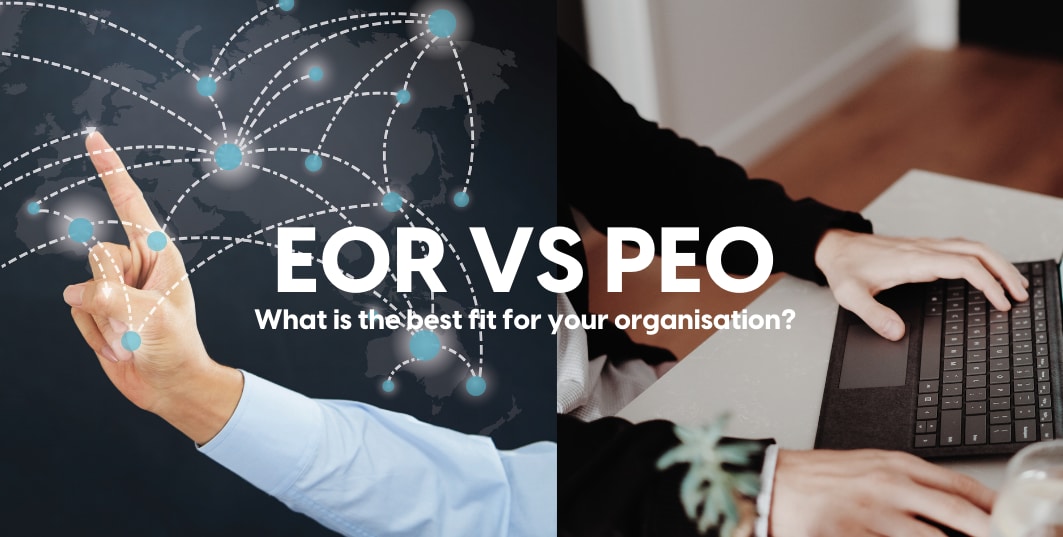Smart businesses reach for innovative solutions to rapidly and compliantly develop their business. PEOs (Professional Employer Organization) and EORs (Employer of Record) are two efficient solutions that can aid in the expansion of these businesses. But PEO and EOR services are different. The primary distinction between PEO and EOR is that a PEO serves as a co-employer whereas an EOR is a full legal employer. Understanding the differences between a PEO and an EOR is the first step toward selecting the best solution according to your company’s needs. This is why we are covering what you should know about PEOs and EORs, their main distinctions, and important considerations that you should think of when selecting a plan for your company.
Professional Employer Organization vs Employer of Record (PEO VS EOR)
Both PEOs (Professional Employer Organization) and EORs (Employer of Record) are two effective solutions that can help navigate the challenges of making your business a success. However, they don’t offer the same services and your company’s employment strategy might benefit more from one than the other. This blog examines the Professional Employer Organization and Employer of Record (PEO VS EOR) and how they differ from each other.
Professional Employer Organization (PEO)
A Professional Employer Organization (PEO) is an organization that collaborates with small and medium-sized enterprises to offer all-inclusive human resource services. To free up your internal teams’ time for their primary responsibilities, PEOs serve as an organization’s outsourced HR department. A PEO is a coemployer. This means, that while using a PEO absolves you of HR-related duties, your firm remains responsible for day-to-day and legal operations, including registering your company when you hire personnel. PEOs often offer the primary services which include employee benefits, tax administration, payroll processing, compliance assistance, HR administration, training and onboarding of employees, hiring and recruitment, employment contracts, and other duties pertaining to HR.
Advantages
- PEOs make the HR procedures simpler with streamlined systems and professional assistance. Less effort is required to manage different HR-related duties.
- Employee benefits from small and medium-sized companies may be more competitively priced with PEOs.
- Because of improved benefits and streamlined HR procedures due to PEOs, there may be an increase in employee satisfaction.
- PEOs aid in the management and mitigation of risks associated with HR.
- PEOs frequently save a lot of HR-related expenditures.
- PEOs effectively manage payroll processing.
- PEOs give entrepreneurs more time to concentrate on their main business operations.
- Regulatory compliance using PEOs lowers legal risks by ensuring that employment rules and regulations are followed.
- PEOs provide resources for training and development.
- PEOs enable HR processes to be easily scaled as the business expands.
- PEOs offer access to personnel and HR specialists.
- PEOs assist with the hiring and onboarding of new employees.
- PEOs promote a more organized and successful onboarding procedure.
Disadvantages
- PEO receives some degree of control over your HR and benefits administration.
- Benefits packages that are generic may not be specifically adapted to meet the demands of the business.
- Transitioning to a PEO model presents challenges. The co-employment role carries financial and legal risks.
- PEOs may not meet very specific or specialized HR requirements. There is less room for changing certain procedures or policies.
- PEOs are frequently ill-prepared to manage compliance with foreign employment laws.
- You may become dependent on a third party for essential HR tasks.
- Workers may not understand the dual-employer arrangement.
- Prices may change according to the size of the workforce and the services used.
- There may be difficulties integrating PRO systems with current business procedures.
- When a third-party entity handles confidential employee data, there will be privacy concerns.
- There may be a potential mismatch between the values and the cultures of the firm.
Employer of Record (EOR)
Employer of Record (EOR) allows businesses to acquire foreign personnel without worrying about legal entity setup or compliance issues by offering comprehensive employment outsourcing services. An EOR provider enables you the freedom to rapidly and legally access almost any market. You may rest easy knowing that professionals are handling all HR and employer-related duties when you work with an EOR provider. An EOR minimizes the time, difficulty, and expenses involved in creating a distributed workforce. The typical EOR services include Employee benefits management, payroll processing, employment contracts, management, serving as the new hire’s legitimate employer, obtaining work permits and visas, giving legal counsel on matters such as severance pay, termination policies, and so forth.
Advantages
- EOR makes employment across borders possible without creating legal corporations.
- EOR guarantees complete adherence to national and local employment rules and regulations across borders.
- EOR makes the employment of foreign workers more efficient.
- EOR reduces legal and financial concerns related to working abroad through risk mitigation.
- EOR avoids wasting time and money on learning and following international labor rules.
- EOR oversees the payment of taxes in each nation and payroll processing.
- EOR manages benefits administration for staff members in compliance with regional guidelines.
- EOR oversees the onboarding and offboarding procedures for staff members abroad.
- EOR manages employment contracts as well as other legal documents.
- EOR provides the freedom to appoint staff in new markets without requiring long-term agreements.
- EOR makes it possible to launch operations in new markets more quickly.
- EOR lessens the effort involved in overseeing global HR responsibilities.
- EOR assists in modifying HR procedures to conform to regional customs.
- EOR offers knowledge and insight into a range of local labor markets.
- EOR removes the requirement to create a local entity in every new market.
Disadvantages
- EOR is usually more costly than using a PEO or handling hiring internally.
- Businesses have less authority over personnel management and HR operations.
- EOR may provide payroll and benefits with less personalization.
- Your business may become dependent on a third party for essential job duties.
- There may be difficulties in coordinating between EOR procedures and corporate policies.
- It’s possible that EORs may not offer specialized services.
- There is a chance that managing foreign workers will not be in line with the company’s ideals and culture.
- A third party can access sensitive employee data.
- There is a scope for an inability to speak with employees directly about specific HR matters.
- Time zone differences or bureaucratic procedures may cause delays in response or action.
- As a result of the EOR acting as an intermediary, there will be less direct connection with employees.
- There may be difficulties in merging EOR technologies with the company’s current payroll and HR systems.
- When switching to an EOR model, internal change management is required.
Differences Between PEO vs EOR
The primary differences between PEO and EOR are summarized in the table below.
| Professional Employer Organization (PEO) | Employer of Record (EOR) |
| PEO serves as a co-employer. | EOR serves as a distinct legal employer. |
| PEO is partially responsible for all risks and liabilities. | EOR is entirely responsible for all risks and liabilities. |
| PEO is usually employed by smaller companies. | EOR is usually employed by larger companies. |
| The business only outsources its HR department to PEO. | EOR plays the role of an employer. |
| PEO leads to higher long-term costs. | EOR leads to lower long-term costs. |
| Hiring international employees requires a legal entity. | Hiring international employees doesn’t require a legal entity. |
The key differences between PEO and EOR are described below.
Structure and Control
In the case of EOR, the EOR takes on the role of the employee’s official employer, creating a direct employment contract between the EOR and the employee. On the contrary, a PEO shares legal responsibilities with its client business, functioning as a co-employer.
Liability
A PEO exposes your company to employment liabilities such as workplace safety because they are co-employers. Although a PEO does not bear sole responsibility for workplace hazards, it can still assist you in managing those risks.
An EOR offers the advantage of acting as your workforce’s real employers, taking on all employment risks and liabilities associated with the services it provides.
Scale
A PEO, functioning as a co-employer, may offer greater benefits to full-time businesses with fewer temporary workers and will need a minimum number of workers to offer particular benefit packages. However, an EOR is less likely to impose employee minimums, making it possible for businesses to hire a single person in a region. EOR provides greater flexibility for those who depend on temporary workers or need talent in other locations.
Scope
A PEO partner provides HR services in regions where your company already has an entity. This is because a PEO does not employ your employees, your company is liable for location-specific labor law compliance. An EOR partner is well-versed in local recruiting procedures and laws, which eliminates the compliance risk associated with a global expansion.
Cost
PEOs and EORs charge similar rates with up-front and long-term charges, often costing a set monthly price per employee or a percentage of payroll. A PEO may also charge a one-time introduction fee to establish services. In the long term, an EOR is typically less expensive than a PEO. An EOR offers insurance and benefits to your workforce, saving your firm money and time. With a PEO, you are still liable for insurance and benefits.
Registration and Licensing
A PEO is a local co-employer that must have a local presence in a defined geographical area. It can not run autonomously since a PEO requires a legal entity to function. However, an EOR can operate without forming an entity in that location, which provides a significant advantage.
Factors to Consider When Picking Between PEO and EOR for Your Business
Control and Nature of Employment
A PEO enables a more customised approach to employee management that aligns with the business’s policies and culture. However, because of their standardized procedures, EORs- the legal employer- may be able to provide less customization in terms of payment arrangements and customized benefits. Furthermore, PEOs’ co-employment model necessitates a precise understanding of roles between the employer and the PEO. This can complicate employee management and raise liability concerns. On the other hand, an EOR takes on all legal employer obligations, freeing the business to concentrate on employee operations.
Cost
PEOs can be more cost-effective because of their co-employer model and economies of scale when it comes to benefit offerings, especially for small and medium-sized businesses. On the other hand, using an EOR service requires a larger cash outlay. The broad legal scope and convenience of recruiting internationally that EOR provides, justifies its cost. Also, in the long term, an EOR is typically less expensive than a PEO if a business intends to expand globally.
The size of the Business
HR resources are frequently scarce in small and medium-sized businesses. With the help of a PEO, small firms may offer competitive employee benefits that are comparable to those of larger corporations without having to take on the full administrative load. Although EORs can assist small and medium-sized businesses as well, they are usually more resource-intensive and may provide services beyond the short-term requirements of smaller companies.
Geographical and Compliance Scope
If your operations are limited to a nation, a PEO is usually sufficient. They are knowledgeable about domestic employment regulations and can efficiently manage HR operations within these parameters. EORs specialize in managing the intricacies of international labor laws, tax legislation, and compliance requirements. This is especially useful for companies employing or intending to employ in numerous countries, each with its legal context.
Global Expansion
EORs are advantageous for companies that are growing internationally since they remove the need for expensive and time-consuming legal entity establishment in each nation. However, PEOs may not have the necessary legal or infrastructure support for hiring people abroad.
Whether you are looking for an expert PEO provider or an EOR provider, Meteors is the perfect partner for you!
Summary
Businesses are now searching abroad for talent more and more, but managing human resources in many legal and cultural contexts has become more difficult as a result of this growth. EOR and PEOs have gained popularity as ways to deal with these issues. This blog explores the differences and similarities between PEO and EOR. It first mentions what PEO and EOR entail along with their advantages and disadvantages. Then, the blog discusses the differences between PEO and EOR. Finally, it addresses the factors to consider when picking between PEO and EOR services. Now if you are looking for either service, Meteors is a leading expert that can provide the service effectively.
Frequently Asked Questions (FAQs)
Which is better for my company: PEO or EOR?
The decision between a PEO and an EOR is influenced by a number of variables, including your company’s size, unique HR and compliance requirements, geographical scope and long-term strategic objective.
Does employing a PEO or EOR come with any risks?
Although these approaches can reduce the number of HR and compliance-related issues, it’s crucial to carefully screen possible suppliers and comprehend the terms of the contract to ensure that they are in line with your company’s goals and any applicable laws.
Do PEOs and EORs provide the same degree of employee control?
No, the degree of control they offer varies. When working with a PEO, the client maintains operations control over staff while delegating some employer duties to the PEO. With an EOR, operational control is retained by the client, but the EOR assumes legal employer duties.
Can a business switch between PEO and EOR if my business needs to change?
As a business’s needs change, they can switch between PEO and EOR services. However, careful planning is necessary for this, taking into account things like contractual duties, transition schedules, and possible effects on staff.





